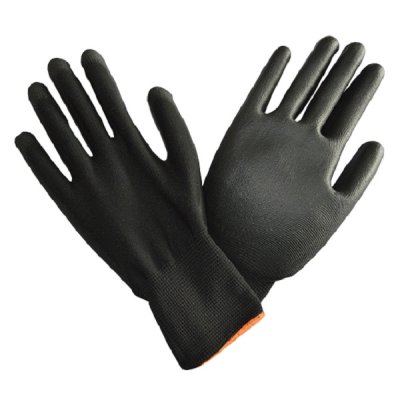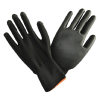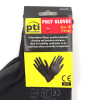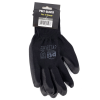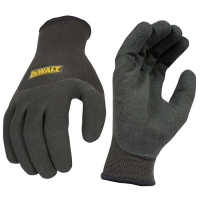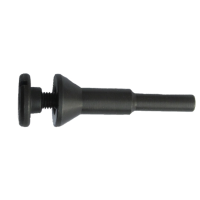Polyurethane-coated palm and fingertips. Elasticated cuffs, breathable backs for comfort. Loss of grip and inflexibility can be frustrating for workers in a range of industries who require the use of gloves to carry out their jobs, but thankfully PU coated gloves offer a great solution These gloves offer an excellent level of dexterity, making them ideal for delicate and precise operations such as assembling and packing small components and are suitable for many industries where general handling and intricate tasks are required. This includes use inside and outside, in dry, wet and oily conditions and in clean and dirty environments.
- For general handling
- Ideal for handling oily or wet components
- Excellent abrasion and tear resistance
- Elasticated cuffs
- Palm dipped to enhance dexterity
- Breathable design keeps hands cool during use
- EN388 3131
PTI Black Poly Gloves
Polyurethane-coated palm and fingertips. Elasticated cuffs, breathable backs for comfort. Loss of grip and inflexibility can be frustrating for workers in a range of industries who require the use of gloves to carry out their jobs, but thankfully PU coated gloves offer a great solution These gloves offer an excellent level of dexterity, making them ideal for delicate and precise operations such as assembling and packing small components and are suitable for many industries where general handling and intricate tasks are required. This includes use inside and outside, in dry, wet and oily conditions and in clean and dirty environments.
- For General handling
- Ideal for handling oily or wet components
- Excellent abrasion and tear resistance
- Elasticated cuffs
- Palm dipped to enhance dexterity
- Breathable design keeps hands cool during use
- EN388 3131
- SKU PTI Black Poly Gloves Size 8 Medium Pack of 12 Pairs
General Information: EN 388:2016
Protective gloves against mechanical risks
According to this standard, characteristics such as abrasion resistance, cut resistance, tearing strength, puncture resistance and impact protection are tested. In conjunction with the pictogram, four numbers and one, or two letters, will be displayed. These signs indicate the performance of the glove

1. ABRASION RESISTANCE
- The material is subjected to abrasion by a sandpaper under a determined pressure
- The protection level is indicated on a scale of 1 to 4 depending on the number of turns required until a hole appears in the material
- The higher the number is, the better the resistance to abrasion
2. CUT RESISTANCE, COUP TEST
- The cut protection is tested
- A knife is passed over the glove material until it cuts through
- The protection level is given by a number between 1 and 5, where 5 indicates the highest cut protection
- If the material dulls the knife during this test, the cut test ISO 13997(TDM test) shall be performed instead, see point 5
3. TEARING STRENGTH
- The force required to tear the glove material apart is measured
- The protection level is indicated by a number between 1 and 4, where 4 indicates the strongest material
4. PUNCTURE RESISTANCE
- Based on the amount of force required to puncture the material with a tip
- The protection function is indicated by a number between 1 and 4, where 4 indicates the strongest material
5. CUT RESISTANCE, TDM TEST ISO 13997
- If the knife gets dull during the coup test, see point 2, this test shall be performed instead
- The result is given by a letter, A to F, where F indicates the highest level of protection
- If any of these letters is given, this method determines the protection level instead of the coup test
ISO 13997:1999 – Determination of resistance to cutting by sharp objects
An alternative cut test recommended for cut protection gloves. Shall be used in EN388:2016 for cut protection gloves where the cut material dulls the cutting knife during testing. A knife cuts with constant speed but increasing force until breakthrough of the cut protection material. Level of protection is given in Newton, the force needed for cut through at 20mm cut length.
6. IMPACT PROTECTION
- If the glove has an impact protection, this information is given by the letter P as the 6th and last sign
- If no P sign, no impact protection is claimed
EN 388:2003
This is the old version of the standard against mechanical risks. The differences compared to the 2016 version are the paper grid in the abrasion test and how to perform testing of cut resistant fibres. Also not applicable to test impact protection.
There are still many protective gloves on the market labelled according to the old version of this standard. These are as good to use as the new marked gloves.
Important to understand: it’s not the gloves performances that have changed. It is the way of testing the performances that has changed

